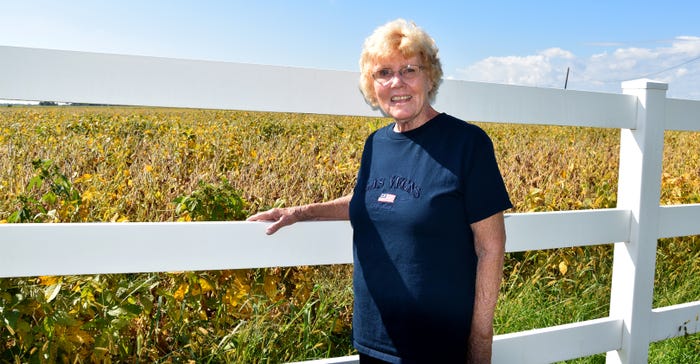November 12, 2018

For nearly 50 years Virginia Reynolds and her late husband, Larry, worked together to manage their farms to conserve soil and protect water quality. After Larry passed away in 2013, she worked with an attorney to write soil and water conservation practice requirements into the leases for her Clarke County cropland.
Virginia says Larry was particular about the way things were done on the farm, and she wanted to hold tenant farmers to the same standard. Larry no-till farmed for decades, planted buffer strips and grassed waterways, and used extended crop rotations with corn, soybeans, oats and hay. “We worked for years doing it that way,” says Virginia. “I wasn’t going to let potential renters come in and do whatever they want.”
Advocate for conservation work
In 1958, at the age of 21, Larry purchased his first farm where he milked cows near Osceola in southern Iowa. After marrying, the couple sold the cropland portion of the Osceola farm in 1965 and used profits to buy their current farm near Weldon. Virginia still owns the timber portion of that Osceola farm. Later, they purchased two other tracts closer to home. In all, Virginia now owns about 625 acres of timber, pasture and cropland.
Virginia was very active on the farm. She did most of the hay cutting and baling, combining and bookwork. “We were a team,” she says. “It worked well for us.”
The Reynolds have three daughters. Two live with their families in central Iowa, and the other resides in the Kansas City area. “None of them are farmers, but they provide a lot of input and are very supportive and advocate for the conservation work I am doing,” she says. Virginia says her daughter’s family who lives in Norwalk will one day move into the family homestead in Weldon.
Lease agreements spell it out
After talking with her attorney, potential tenants and an auctioneer, Virginia decided to rent her three sections of cropland separately. Virginia included specific, high conservation standards in the lease language. “It’s absolutely no-till, and they can’t take anything off the soil [such as baling cornstalks],” she says. “My lawyer was helpful. He asked me good questions and included just what I expected in the lease agreements.”
That specific language has been helpful. “One of my renters baled cornstalks. I was just furious,” Virginia says. “I told him, ‘You can’t do that.’ I read it verbatim from his contract. He apparently didn’t read his contract. I think we’ve got that straightened out.”
Virginia says another tenant used a field cultivator. “They think I don’t see anything going on. Well, I do,” she says, chuckling. “They think I’m just the meanest person in the world, but I won’t let them take advantage of me.”
Virginia also requires renters to mow the pasture. “I told [my tenant], ‘I did that for years. You can do that. It’s fun!’”
Adding other conservation practices
Many of Virginia’s tenant experiences have been positive, though. Brian Mateer approached her about collaborating on cover crops for the land he is renting. “Brian came to me and said he thought this would be good, and I agreed, absolutely,” Virginia says. “We agreed that I would pay for the airplane, and he paid for the seed.”
In fall 2017, Mateer aerial-applied cereal rye on about 100 cropland acres following corn.
Mateer, who farms many other acres, had prior experience using cereal rye cover crops. “He uses cover crops to improve soil health, reduce soil erosion, and as a livestock feed supplement,” says Dennis Schrodt, district conservationist for USDA’s Natural Resources Conservation Service in Osceola.
“Brian uses cover crops on his other farms,” Schrodt adds. “He knows how to manage them and makes sure he doesn’t end up with a mess in the spring. And having his cows out there helps add some microbial activity to the soil that it otherwise wouldn’t get.”
Virginia has also added terraces on her cropland in recent years to treat soil erosion concerns, with assistance from NRCS and the Rathbun Land and Water Alliance (RLWA). She is working with Schrodt to build 4,600 more feet of terraces next year through the Environmental Quality Incentives Program.
“Larry wasn’t big into terraces, but I see the value in them, and I think he might have changed his mind,” she says.
Stewardship awards well-deserved
For her conservation efforts, Virginia received the 2017 RLWA Rathbun Lake Protectors Award and a 2018 Iowa Farm Environmental Leader Award at the Iowa State Fair in August, following a nomination from RLWA. Her home farm is the westernmost section in the Rathbun Lake Watershed.
“I really enjoy working with Virginia,” Schrodt says. “She’s knowledgeable, receptive and makes informed decisions. She’s a great example for other landowners who rent out their crop ground.”
For more information about farm leases, go to sustainablefarmlease.org. Drake University Ag Law Center’s Sustainable Agricultural Land Tenure Initiative assists landowners and farmers in developing farm lease arrangements that are profitable and sustainable for the landowner, farmer, the community and the land. Read more of Iowa’s USDA conservation success stories at bit.ly/IANRCSSuccess.
Johnson is a public affairs specialist with USDA Natural Resources Conservation Service in Des Moines.
About the Author(s)
You May Also Like




